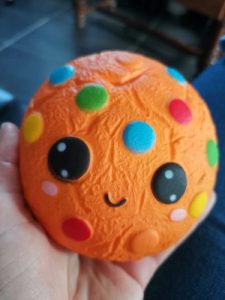First there were the whirly gigs, then the squishies, then, at that point, the pop toys, then the false game regulators, bendable this-and-that is and various other hand-held things that my children could control with one hand.
At first, I varied between feeling gently enthused and skeptic about them.
Not at all like most toys, especially those advertised to young men, fidgets weren’t about rivalry or viciousness. They weren’t marked product associated with weapon-employing heroes. Nor did they, likewise with “blind box” toys, use shock to entice children to continue to purchase more stuff. Indeed, kids gather fidgets, yet, essentially I would say, in far more modest amounts than other toys. Those were generally beneficial things.
The allure of the fidget
“My mentality towards it is, what took the toy business such a long time to sort out this?” said Richard Gottlieb, CEO of Global Toy Experts and distributer of The Toy Intelligencer, making sense of the allure of fidget toys.
Fidget toys take into consideration manipulative play, he made sense of, like the fulfillment one gets from whirling a pencil around one’s fingers. Their collectability additionally makes them a good time for youngsters, who appreciate various shapes and shadings and exchanging with their companions.
The play isn’t muddled or about accomplishing a specific outcome, which might be key to their prominence. Youngsters are occupied and worried, and fidgets can offer something to manage without truly doing much by any stretch of the imagination.
“The normal child works 60 hours every week assuming we consider anything administered by a grown-up work,” Gottlieb said. “Here and there the main spot they get to unwind is in the rearward sitting arrangement of the vehicle, and something like the whirly gig or Pop It is compact, and they can simply pause for a minute or two and draw in with it.”
A basic need to move and feel
Katherine Isbister, a human PC connection and games scientist and teacher of computational media at University of California, Santa Cruz, accepts a large part of the allure of fidget toys lies in their non-advanced, very, all things considered, characteristics.
“We are primates, we have mind blowing dexterity, we have an unbelievable feeling of touch, and we have these muddled proprioceptive frameworks, which is a significant sense we have yet many don’t know exists,” she said. “This is the feeling that permits us to know where we are in space.”
All people hunger for material commitment, yet kids truly need it. Those little fidgeters may be taking advantage of an oblivious need to prepare their fine coordinated abilities, she said.
In the study hall
Karen Bloom, a center school math instructor in Piedmont, California, who works with neurodiverse kids, said she’s seen fidget toys help children’s focus and harmed children’s fixation. At times it’s similar toy in the possession of two distinct children or similar toy in the possession of a similar child, on two unique days.
“My methodology is that assuming I see it is helping you, I will allow you to utilize it, and in the event that I see it is an interruption, I won’t,” she said. “Whenever they begin flying across the room, when they are squabbling about which one, they move set aside for some time.”
She even gathers fidgets to offer her understudies to help them during difficult to focus minutes. Specifically, youngsters with A.D.D., A.D.H.D. or then again with mental imbalance range confusion can focus better when a little piece of their mind is involved by something different.
At the point when understudies are chipping away at their own, fidgets can help, Bloom said. Be that as it may, when understudies should be by and large captivating in more profound inquiries, or cooperating, the fidgets can haul them out of the discussion.
“I don’t bring them out during bunch examples,” she said.
Ways of dealing with hardship or stress
The need to fidget in class and outside of class probably got a knock during the pandemic, said David Anderson, clinical analyst at the Child Mind Institute, a non-benefit looking to change kid and young adult psychological well-being.
“We know from the examination that individuals from all age bunches are revealing that they are more anxious,” he said. Pressing, popping, turning and clicking can offer some delivery.
He likewise thinks the ascent of fidget toys might be associated with the ascent of social and enthusiastic learning and psychological well-being mindfulness among instructors. The more educators see the entire kid in school and think about the manner in which youngsters’ mental state influences their capacity to learn, the more receptiveness there has been to mediations to assist them with managing their sentiments.
Anderson alerts guardians to have some misgivings of any strong cases made by fidget makers about how, when and the amount they help kids quiet down and concentrate since the science is as yet uncertain. All things considered, people have long self-alleviated through actual work or tangible feeling, and the present youngsters are the same.
“Fidget toys (Pop It, Simple Dimple, Wacky Track, Fidget Cube, Infinity Cube Fidget, Monkey Noodles,…) can assist the child with discovering that when I am feeling something awkward, there may be a way that I can animate myself to adapt to that feeling until something changes,” Anderson said, noticing that is a significant fundamental ability.
What will work for any person with regards to tactile excitement can change, as can regardless of whether extra feeling helps or damages their fixation. A few grown-ups can work with music, and others need quietness. Anderson said fidgets can be one device in a tool stash of potential self-alleviating instruments that children ought to investigate.


